 |
Among the most ingenious ways to transform chickpea flour is to extrude it through a brass device used in India to make sev – a kind of fried noodle that goes into a variety of dishes. There are various other machines that will work just as well, a small hand-held noodle extruder, a ricer and even a cookie press with a perforated die. Here I have obviously desecrated a revered snack food, but it is so remarkably delicious, I implore you to try it.
- 1 c chickpea flour
- 1 tsp vegetable oil
- ½ tsp salt
- ½ tsp turmeric
- 1/8 tsp paprika
- 1/8 tsp cayenne pepper
- Water (less than ¼ cup)
- 2 inches of vegetable oil in a pan
- 1 ounce mozzarella
- 1 Roma tomato
- 2 tbs sour cream
- ¼ c fresh cilantro
- 1 tbs milk
- 1/8 tsp of salt
Mix the
first 6 ingredients and add just enough water so it becomes a stiff dough. If
necessary add a little more chickpea flour and form into a cylinder with your
hands. Slide it into your press. There is no need to oil it, your hands, or
anything. Now heat your oil in the pan. To test take a tiny bit of the dough
and put it in the hot oil. See if it floats up. If it sinks and no bubbles form,
it’s not hot enough, if it browns quickly, it’s too hot. Adjust heat
accordingly. Then put the plunger in your extruder and turn the crank directly
over the oil, filling the whole pan with noodles. With a pair of metal skewers,
start turning them over. Cook on both sides about 5 minutes or until golden.
Remove with a slotted spoon or strainer and place on paper towels to cool.
Then
arrange on a baking sheet covered with tin foil, sprinkle on the cheese and the
tomato, chopped. Place in a toaster oven at 350 degrees until the cheese is
melted. While that is heating, mix the sour cream, chopped cilantro and salt,
thin with milk until it’s pourable. Take the nachos out of the oven a drizzle
with the sour cream mixture. Be forwarned: it’s awfully messy, but there’s no
other way to eat it but with your fingers.















